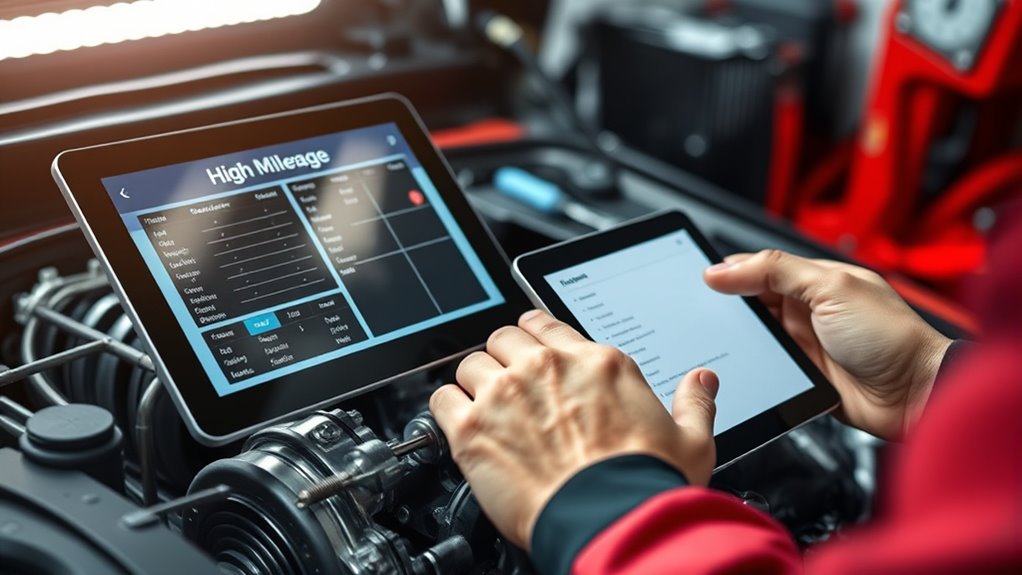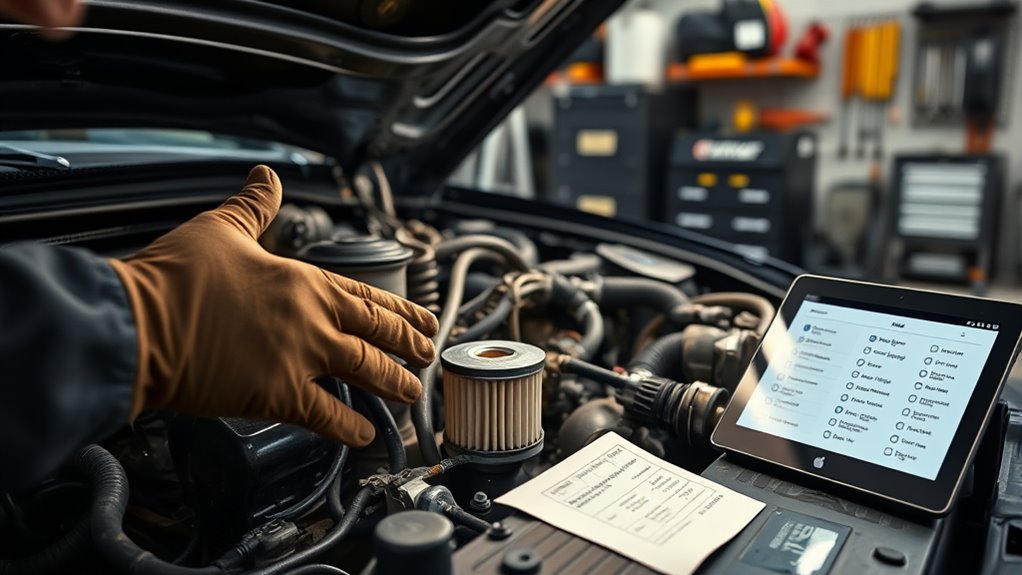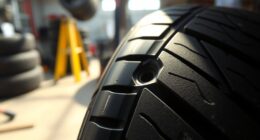To keep your high-mileage vehicle running smoothly, follow a strict maintenance plan that includes regular oil changes, tire rotations, and fluid checks. Pay close attention to your owner’s schedule and increase service frequency if you drive in harsh conditions or notice performance issues. Track all repairs and inspections carefully to prevent costly breakdowns and extend your vehicle’s lifespan. If you stay disciplined, you’ll find it easier to maintain reliability — and there’s more to discover to optimize your car’s care.
Key Takeaways
- Follow a tailored maintenance schedule that increases service frequency for aging engines and high-mileage wear.
- Prioritize regular oil changes, checking owner’s manual for updated intervals suited for high-mileage vehicles.
- Rotate tires every 5,000 to 7,000 miles to ensure even wear and maintain optimal handling.
- Regularly inspect and replace key components like brakes, suspension, and fluid levels to prevent breakdowns.
- Keep detailed records of all maintenance activities to track service history and plan future upkeep effectively.

As your vehicle racks up high mileage, sticking to a well-planned maintenance schedule becomes essential to keep it running smoothly and reliably. Regular maintenance helps prevent costly repairs and extends the lifespan of your vehicle. One of the most critical aspects of this routine is adhering to proper oil change intervals. As engines age, they tend to burn oil more quickly and accumulate debris, making it imperative to change your oil more frequently than when the vehicle was new. Check your owner’s manual for recommended oil change intervals, but don’t hesitate to increase the frequency if you notice increased engine noise, reduced performance, or if you often drive in harsh conditions like stop-and-go traffic, extreme temperatures, or dusty environments.
High-mileage vehicles need more frequent oil changes to stay reliable and perform well.
In addition to oil changes, sticking to a consistent tire rotation schedule becomes increasingly important as your vehicle accrues high mileage. Regular tire rotations help ensure even tire wear, which is essential for maintaining proper traction, improving fuel efficiency, and preventing premature tire replacement. When tires wear unevenly, it can lead to handling issues and additional stress on suspension components. Typically, you should rotate your tires every 5,000 to 7,000 miles, but this can vary depending on your vehicle and driving habits. Always consult your owner’s manual for specific recommendations, and consider more frequent rotations if you notice uneven tire wear or if you drive on rough roads regularly.
Maintaining high-mileage vehicles also means paying attention to other key components such as the cooling system, brakes, and suspension. As your vehicle ages, parts tend to wear out faster, so inspecting and replacing them proactively saves you from unexpected breakdowns. Regularly checking fluid levels—transmission, brake, coolant, and power steering—can also prevent severe damage and ensure everything operates smoothly. Additionally, projector technology like contrast ratio and color accuracy can significantly impact the performance and enjoyment of your home entertainment setup, much like how proper maintenance enhances vehicle performance.
Sticking to a schedule that emphasizes these routine tasks requires discipline but pays off in the long run. Keep detailed records of all maintenance performed, so you always know what has been done and what’s due next. If you’re unsure about specific intervals or maintenance procedures, consult a trusted mechanic experienced in high-mileage vehicle care. They can help tailor a maintenance plan suited to your vehicle’s age, condition, and your driving habits. Ultimately, consistent upkeep will keep your high-mileage vehicle running efficiently, save you money over time, and provide peace of mind whenever you’re on the road.
Frequently Asked Questions
How Can I Tell if My High-Mileage Vehicle Needs Major Repairs?
You can tell your high-mileage vehicle needs major repairs if it starts making unusual engine noises or if diagnostic tests reveal issues like low compression or sensor failures. Pay attention to warning lights on the dashboard, strange vibrations, or a decrease in performance. Regularly schedule diagnostic tests to catch problems early, and don’t ignore signs like difficulty starting or unusual exhaust fumes, as these often indicate that major repairs are needed.
Are There Specific Brands of Parts Better for High-Mileage Vehicles?
Imagine you’re at a bustling market, and you spot a stall with shiny, well-packaged parts. You realize that trusted brands with good reputation often offer higher-quality aftermarket options designed for high-mileage vehicles. These brands tend to last longer and perform better, providing peace of mind. So, always check the brand reputation before purchasing parts, ensuring you’re choosing reliable aftermarket options that keep your vehicle running smoothly for miles to come.
How Often Should I Replace the Timing Belt in High-Mileage Cars?
You should replace the timing belt in your high-mileage car every 60,000 to 100,000 miles, depending on the manufacturer’s recommended replacement interval. Regularly inspect it for signs of wear, such as cracks or fraying, and don’t wait until it fails. Staying on top of the timing belt replacement interval helps prevent costly engine damage, keeping your vehicle running smoothly and reliably for years to come.
What Are Signs of Impending Transmission Failure in High-Mileage Vehicles?
Imagine driving your high-mileage car when you notice slipping gears or delayed engagement. These are signs of impending transmission failure. You should regularly check your transmission fluid for discoloration or burnt smell, and monitor clutch performance if applicable. If you experience difficulty shifting or unusual noises, it’s time to get your transmission inspected. Catching these signs early can save you costly repairs and keep your vehicle running smoothly.
Can Regular Oil Changes Extend My Vehicle’s Lifespan Beyond Recommended Mileage?
Yes, regular oil changes can extend your vehicle’s lifespan beyond the recommended mileage. By maintaining good oil longevity, you reduce engine wear and keep engine parts well-lubricated, preventing premature breakdowns. Consistent oil changes help remove dirt and debris, ensuring peak engine performance. This proactive approach can delay major repairs, improve fuel efficiency, and prolong your vehicle’s overall life, especially in high-mileage vehicles where engine stress is greater.
Conclusion
By sticking to a tailored maintenance plan, you can extend your vehicle’s lifespan and save money in the long run. For example, if you regularly replace your timing belt around 100,000 miles, you’ll prevent costly engine damage. Consider John, who maintained his high-mileage sedan diligently, avoiding major repairs and selling it after 200,000 miles for a good price. Consistent upkeep keeps your vehicle reliable and ready for the road.








